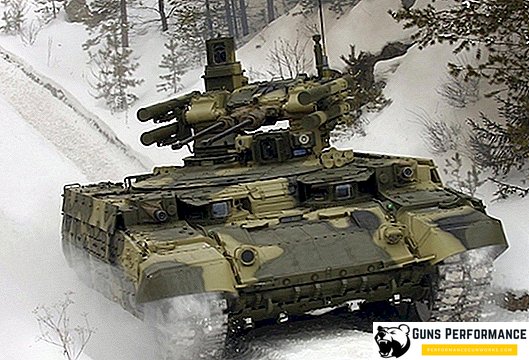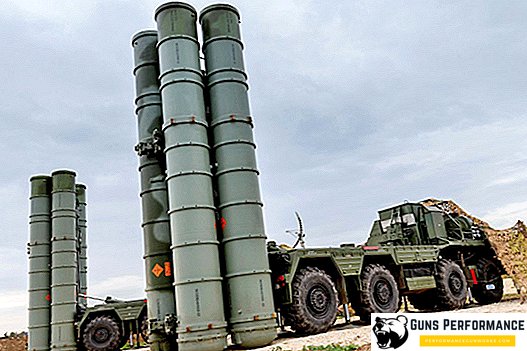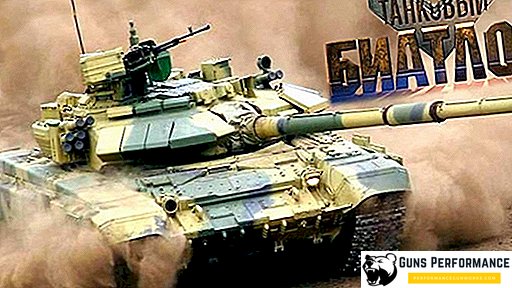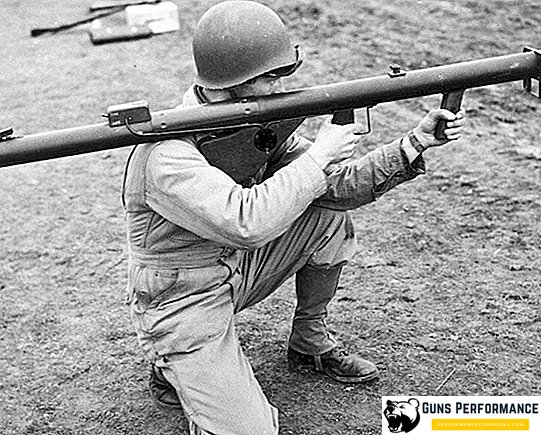Small arms are the main weapon in all armies of the world. It is used in most armed clashes. However, the real effectiveness of its use is not only based on the characteristics of the weapon itself or the level of professionalism of the fighters, it also depends on the quality of the aiming devices mounted on the weapon. Today, the military industry produces a full range of different types of sights for such weapons. Sights can be open, optical, collimator, night, as well as thermal imaging.
Open sight
An open sight consists of a rear sight and a front sight, which are located on the same axis. The process of aiming occurs when a visual combination of the pillar slot with the front sight and the goal itself. If aiming is done correctly, the front sight will be in the slot of the rear sight in such a way that the gaps on the left and right sides will be the same. In this case, the upper face of the front sight must be flush with the top cut of the rear sight. During the shooting of weapons, the aiming bar is adjusted horizontally and vertically.
Sometimes there are adjustable flies. In recent years, fiber optic flies with a bright green or red color are widespread. This innovation simplifies the process of aiming in the twilight. An open sight can be handy when shooting at moving or static targets.
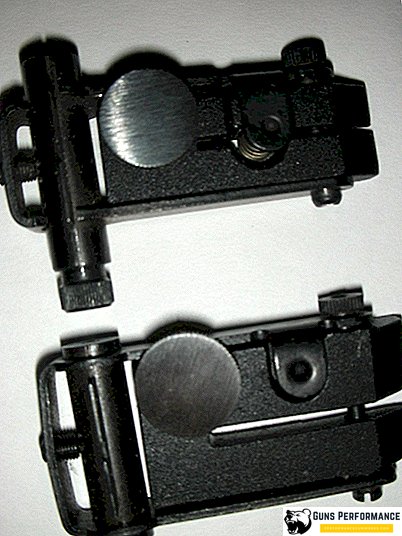
Open sight: pros and cons
A plus:
- Cheapness;
- Simplicity of design;
- Low weight;
- Easy maintenance;
- Strength.
Minus:
- Inconvenient aiming;
- Low accuracy / accuracy of shooting.
Optical sight
Optical sight is considered more perfect than open sight. Its use improves accuracy and accuracy in firing. This is due to a visual increase in the target, as well as the exclusion of re-accommodation (change of focus) of the eyes. In the optical sight, the aiming mark with the image of the target is combined in the focal plane of the lens of the optical system. Most riflescopes have some special features. For example, a limited field of view (this makes it difficult to search for targets), as well as a constant exit pupil diameter, which, based on the observation conditions, vary from 2 to 8 mm.
In addition, observing the target with an optical sight, the eye pupil is combined with the exit pupil of the device, otherwise the occurrence of errors during the aiming process is not excluded. Such flaws devoid collimator sight.
The optical sight is a complex optical device that repeatedly increases the accurate targeting of small arms to the target, which leads to greater efficiency when shooting. Such sights for small arms can be installed on smooth-bore or rifled varieties. Structurally, optical sights resemble small telescopes.

Optical sight: pros / cons
A plus:
- Convenient aiming;
- Increasing the size of the visible target;
- High accuracy / accuracy when shooting.
Minus:
- A large weight can lead to an imbalance of the weapon and, consequently, to fatigue of the shooter, especially when shooting while standing with hands;
- High cost;
- The complexity of the device, so the shooting of this sight in a novice shooter often causes inconvenience, however, as well as its setting;
- For pistols do not apply.
Collimator sight
The collimator sight is considered the best target when shooting at moving targets. For the first time it was used in aviation, because the pilot's life depended on the speed of aiming, as well as the correct lead when firing at fast-flying targets. For small arms such use was found relatively recently.
In the process of aiming the shooter combines the aiming mark with the target. At the same time, his eye focuses exclusively on two objects: a luminous mark and a target. After the arrow moves the eye from the sight, the aiming mark will visually remain on the target and move relative to the gunman’s gaze. Thus, the position of the weapon relative to its eye is not so important for accurate fire. This creates many advantages, when shooting in a position with hands, in the process of movement, at fast-moving targets, etc. Collimator sights have proven to be good for hunting with smooth-bore weapons.

The positive properties of the collimator sight (sight point) are achieved because of its special design. So, the aiming mark is reflected on the lens of the sight in the form of a light source projected onto it. Through this lens, the shooter observes the target, by combining the target with the aiming mark.
The aiming marks can be the most diverse: from the elementary red point, to a figure with a certain number of circles of different diameters, simplifying the process of calculating the lead time during firing at moving targets. Most sights have a slight increase. As a rule, the multiplicity of the sight can be no more than 2 units, which are indicated by the manufacturers.
Varieties of collimator sights
The collimator sights differ by type:
- Open;
- Closed.
In closed collimator sights, the light source is located inside the body, most often in the form of a tube. A lens is formed with a reflecting lens in front, and an eyepiece with an additional lens behind the tube. Thus, the light source is in a completely closed form from the external environment and is protected from moisture and pollution. However, this will not have to be paid for with the best visibility, as well as a reduction in the field of view through the scope.

Open collimator sights have only one lens and an open light source. This design feature provides better visibility to the shooter, since the target is seen through a small frame with a single lens. However, this design is easily exposed to pollution, as well as to weathering, which can distort the projection of the image on the lens.
Sights are fixed directly to the receiver. Mounts are divided into two types:
- Dovetail;
- Weaver.
Reflex Sight: Pros / Cons
A plus:
- Convenient aiming at moving and static targets;
- Compact - small sight;
- Low weight;
- The possibility of long-term training, in which the eye is not tired;
- Convenient use on pistols.
Minus:
- Open sights may be contaminated.
Feature Hunting Sights
For anyone, not necessarily a novice hunter, the right choice of sight is extremely relevant.

The selection of the sight is carried out taking into account a variety of circumstances, therefore, it is necessary to treat this important event extremely competently. Experts recommend prior acquaintance with existing types of sighting devices for hunting. However, it is still advisable to pick up a small sight in order to have time to make a long-awaited shot in the event of a sudden face-to-face collision with a wild animal or a game.
Variety of hunting sights
Hunting sights mainly come in the following varieties:
- Optical;
- Collimator;
- Laser;
- Night vision.
All of the above varieties of hunting sights have their advantages and disadvantages, as well as the feature of operation and the most varied efficiency, but in general they all meet the same characteristics as the rifle scopes.
Night sight
Night vision sight has a very complex design. The principle of its operation is based on the effect of enhanced image brightness, as a result of which it is distinguishable in dark conditions. Most modern night vision sights, as a rule, operate in two modes:
- Day;
- Night.

Such an aiming device allows accurate aimed fire, not only at short distances, but also at a great distance from the target. Most models of scopes are equipped with a zoom system. Thanks to this system, it is possible to increase the size of the object in the lens, depending on the circumstances, as well as on what type of weapon is planned to be used for firing.
The disadvantage of the overwhelming majority of night vision sights is:
- Extremely high cost compared to others, especially if it is not a night sight;
- Complex in all respects the design of the device, which at any time can fail. This can occur, for example, in the fall or any other negative external influence;
- Size is not a small sight.
Thermal sight
Today, a thermal sight is such a device, without which no professional hunting will be carried out. Various foreign and domestic manufacturers offer a wide selection of these devices.
What is a thermal sight?
This is a device that allows the shooter to observe the target in conditions of limited visibility.

The thermal sight is used in the following conditions:
- Fog;
- Dustiness;
- High humidity levels.
The operation of this device occurs regardless of the level of light, due to the use of infrared rays, as well as the calculation of the difference between thermal temperatures. The main design of all thermal sights is optics, which allows firing at long or short distances.
Moreover, this type of equipment is well adapted to many types of small arms. Thermal sight allows you to observe, as a rule, for living, warm-blooded objects:
- Animals;
- By humans.
Thermal sights: pros / cons
A plus:
- The possibility of use at night or in dark rooms;
- Easy installation;
- Convenient, easy operation;
- A wide range of uses;
- On more modern models - the possibility of shooting from around the corner.
Minus:
- Few people know, but some models of thermal imaging sights can “blind” the shooter in case of a sudden flash of light.

You should be aware of the fact that there is some difference between thermal imagers and thermal sights. In essence, their purpose is somewhat similar, however, the latter has a more compact size (small sight), as well as a more solid frame basis (including shots), in contrast to the thermal imager. Moreover, thermal sights provide a faster frame rate, and also function without delaying the shooting.
Brief conclusions
Choosing a "optics", for example, a sniper scope, it is advisable to immediately determine the range of its tasks. In particular, shooting with a sight with more than 4-fold magnification is recommended using the stop, and only at fixed targets. Riflescopes for rifles with less than 4x magnification should be used for firing at moving targets. It should also be remembered that with a strong recoil of the weapon there is a risk of getting a blow in the eye with an eyepiece.

Selecting optical sights, for example, for a sniper, it is advisable to look at it at a distant object. The image should be clear, sharp, with excellent resolution of details within the entire field of vision. If the sight is variable multiple, you should make sure that when the magnification changes, the aiming crosshair does not shift, a distinct image of the target is preserved.
It is advisable to stop your choice on proven models of well-known manufacturers, since riflescopes are complex multi-component optical instruments. It is impossible to familiarize yourself with most of their technical characteristics without special equipment, for example, to learn resistance to shock overload when fired. Selecting the "optics", special attention should be paid to the absence of scratches or bubbles in the lenses, as well as dust or other foreign objects inside the sights. Whatever optical device is chosen, it is advisable not to spare money only on the best sights.


